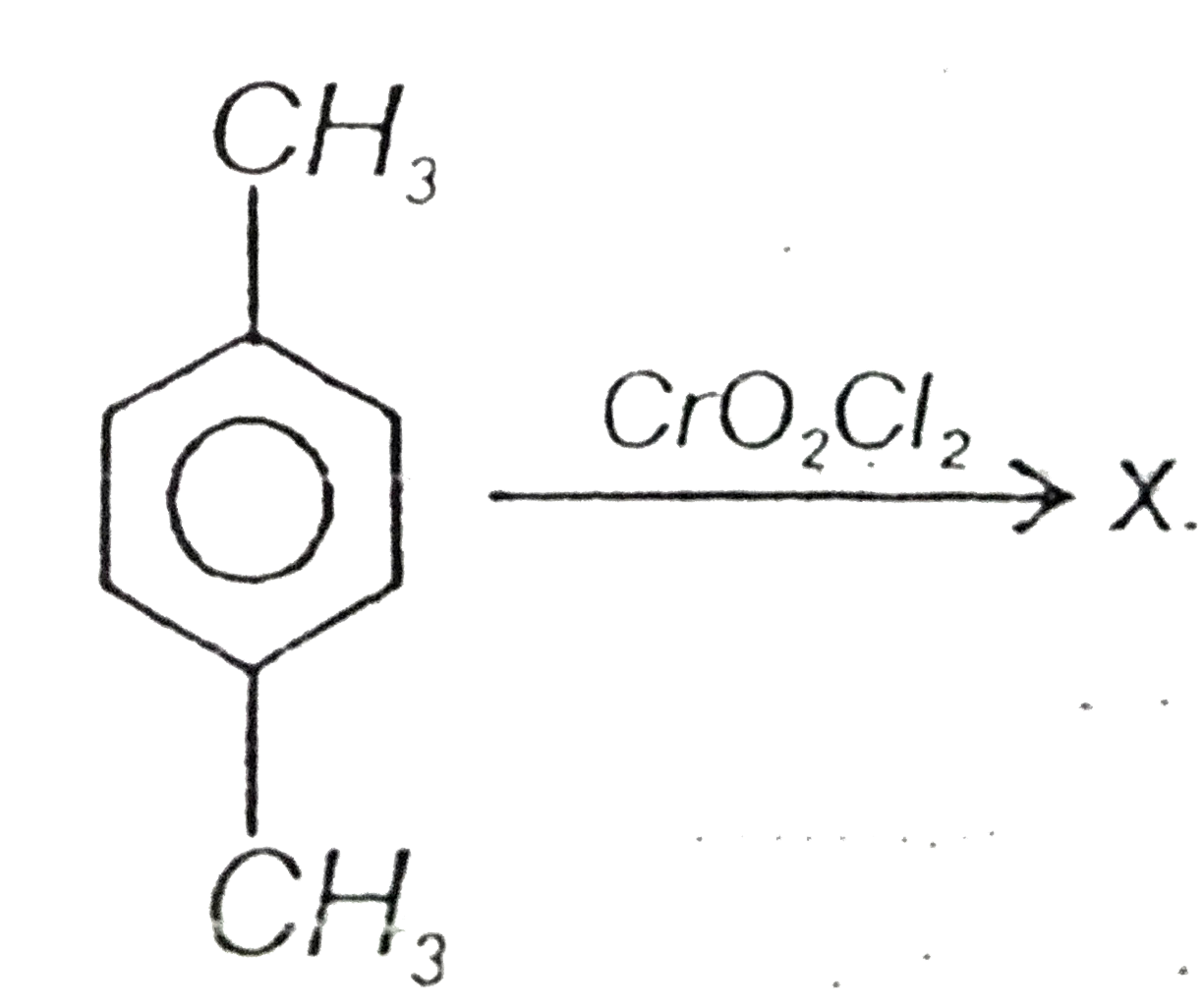Ph−CH=CH−CHO(i)CH3CH2MgBr−−−−−−−−−−−→(ii)H3O⊕−−−−−−→(X)Cu,Δ−−−→(Y)
X is 1,4-addition product , Y is Ph−C∣∣O−CH=CH−CH2−CH3
X is 1,2-addition product , Y is Ph−CH=CH−C∣∣O−CH2−CH3
X is 1,4-addition product , Y is Ph−CH=CH−C∣∣O−CH2−CH3
X is 1,2 addition product , Y is Ph−C∣∣O−CH=CH−CH2−CH3
The correct Answer is:B
To solve the problem step by step, we will analyze the reaction of the given compound with the Grignard reagent and subsequent steps.
Step 1: Reaction with Grignard Reagent
The starting compound is an alpha-beta unsaturated aldehyde, specifically Ph-CH=CH-CHO. When this compound is treated with the Grignard reagent (CH₃CH₂MgBr), the nucleophilic ethyl group (C₂H₅⁻) from the Grignard reagent will attack the electrophilic carbon of the carbonyl group (C=O) in the aldehyde.
Reaction:
1. The nucleophile (C₂H₅⁻) attacks the carbonyl carbon (C=O) of the aldehyde.
2. This leads to the formation of a tetrahedral intermediate.
3. The intermediate collapses, resulting in the formation of an alcohol.
Product (X):
The product after this step will be:
Ph-CH=CH-CH(OH)-C₂H₅
This is an alpha-beta unsaturated alcohol.
Step 2: Acidification
Next, we will treat the product (X) with acid (H₃O⁺). This step is typically done to protonate the alkoxide ion formed in the previous step, converting it into an alcohol.
Reaction:
1. The alkoxide oxygen (O⁻) will pick up a proton (H⁺) from the acid.
2. This results in the formation of the corresponding alcohol.
Product (X) remains the same:
Ph-CH=CH-CH(OH)-C₂H₅
Step 3: Reaction with Copper and Heating
The final step involves heating the product (X) in the presence of copper (Cu). This step typically leads to oxidation of the alcohol group, converting it into a ketone.
Reaction:
1. The alcohol group (–OH) will be oxidized to a carbonyl group (C=O).
2. The double bond remains intact.
Final Product (Y):
The final product after this step will be:
Ph-CH=CH-CO-C₂H₅
This is an alpha-beta unsaturated ketone.
Summary of Products
- After Step 1: X=Ph-CH=CH-CH(OH)-C₂H₅ (alpha-beta unsaturated alcohol)
- After Step 2: X remains the same (after acidification)
- After Step 3: Y=Ph-CH=CH-CO-C₂H₅ (alpha-beta unsaturated ketone)
Final Answer
The final product (Y) is an alpha-beta unsaturated ketone.
---
The starting compound is an alpha-beta unsaturated aldehyde, specifically Ph-CH=CH-CHO. When this compound is treated with the Grignard reagent (CH₃CH₂MgBr), the nucleophilic ethyl group (C₂H₅⁻) from the Grignard reagent will attack the electrophilic carbon of the carbonyl group (C=O) in the aldehyde.
1. The nucleophile (C₂H₅⁻) attacks the carbonyl carbon (C=O) of the aldehyde.
2. This leads to the formation of a tetrahedral intermediate.
3. The intermediate collapses, resulting in the formation of an alcohol.
The product after this step will be:
Ph-CH=CH-CH(OH)-C₂H₅
This is an alpha-beta unsaturated alcohol.
Next, we will treat the product (X) with acid (H₃O⁺). This step is typically done to protonate the alkoxide ion formed in the previous step, converting it into an alcohol.
1. The alkoxide oxygen (O⁻) will pick up a proton (H⁺) from the acid.
2. This results in the formation of the corresponding alcohol.
Ph-CH=CH-CH(OH)-C₂H₅
The final step involves heating the product (X) in the presence of copper (Cu). This step typically leads to oxidation of the alcohol group, converting it into a ketone.
1. The alcohol group (–OH) will be oxidized to a carbonyl group (C=O).
2. The double bond remains intact.
The final product after this step will be:
Ph-CH=CH-CO-C₂H₅
This is an alpha-beta unsaturated ketone.
- After Step 1: X=Ph-CH=CH-CH(OH)-C₂H₅ (alpha-beta unsaturated alcohol)
- After Step 2: X remains the same (after acidification)
- After Step 3: Y=Ph-CH=CH-CO-C₂H₅ (alpha-beta unsaturated ketone)
The final product (Y) is an alpha-beta unsaturated ketone.
Topper's Solved these Questions
- BOOK - RESONANCE ENGLISHCHAPTER - CARBONYL COMPOUNDS (ALDEHYDES & KETONES ) & CARBOXYLIC ACID EXERCISE - PART- IV13videos
CARBONYL COMPOUNDS (ALDEHYDES & KETONES ) & CARBOXYLIC ACID
- BOOK - RESONANCE ENGLISHCHAPTER - CARBONYL COMPOUNDS (ALDEHYDES & KETONES ) & CARBOXYLIC ACID EXERCISE - Exercise-31videos
CARBONYL COMPOUNDS (ALDEHYDES & KETONES ) & CARBOXYLIC ACID
- BOOK - RESONANCE ENGLISHCHAPTER - CARBONYL COMPOUNDS (ALDEHYDES & KETONES ) & CARBOXYLIC ACID EXERCISE - Exercise-2 Part-I1videos
CARBONYL COMPOUNDS (ALDEHYDES & KETONES ) & CARBOXYLIC ACID
- BOOK - RESONANCE ENGLISHCHAPTER - BIOMOLECULES & POLYMEREXERCISE - ORGANIC CHEMISTRY(Biomolecules & Polymer)34videos
BIOMOLECULES & POLYMER
- BOOK - RESONANCE ENGLISHCHAPTER - CHEMICAL KINETICSEXERCISE - PHYSICAL CHEMITRY (CHEMICAL KNIETICS & RADIOACTIVITY)49videos
CHEMICAL KINETICS
Similar Questions
Knowledge Check
- Question 1 - Select One
Compounds (A) and (C ) in the following reactions are
CH3CHO(i)CH3MgBr−−−−−−−−→(ii)H2O(A)H2SO4,Δ−−−−−−→(B)Hydroboration oxidation−−−−−−−−−−−−−−→(C)AidenticalBpositional isomersCfunctional isomersDoptical isomers. - Question 2 - Select One
Compounds A and C in the following reaction are
CH3CHO(i)CH3MgBr−−−−−−−−→(ii)H2OAH2SO4.Δ−−−−−−→(B)Hydroboration oxidation−−−−−−−−−−−−−−→(C)AidenticalBpositional isomersCfunctional isomersDoptical isomers. - Question 3 - Select One
Compounds A and C in the following reaction are
CH3CHO(i)CH3MgBr−−−−−−−−→(ii)H2OAH2SO4.Δ−−−−−−→(B)Hydroboration oxidation−−−−−−−−−−−−−−→(C)AidenticalBpositional isomersCfunctional isomersDoptical isomers.
Complete the following reactions:
(i) CH3−CH3∣C∣Cl−CH2CH3alcKOH−−−−→ΔAO3−−−−−→Zn/H2O(B+C)
(ii) CH3ICH−CH3alcKCN−−−−→A(i)SnCl2/HCl−−−−−−−−−−−−→(ii)H2O.OH.H2O2B
(iii) HCNHCl/AlCl3−−−−−−→A(i)C6H6Δ−−−−−−−−−−→(ii)(H2O)/H−B
(iv) View Solution
View SolutionComplete the following reaction sequence :
CH3−O∣∣C−CH3(i)CH3MgBr−−−−−−−−→(ii)H2O(A)Na metal−−−−→ether(B)CH3−Br−−−−−→(C)View SolutionComplete the following reaction sequence :
CH3−O∣∣C−CH3(i)CH3MgBr−−−−−−−−→(ii)H2O(A)Na metal−−−−→ether(B)CH3−Br−−−−−→(C)View SolutionCompounds A and C in the following reaction are
CH3CHO(i)CH3MgBr−−−−−−−−→(ii)H2OAH2SO4.Δ−−−−−−→(B)Hydroboration oxidation−−−−−−−−−−−−−−→(C)View SolutionFill in the reagents for the given conversion :
CH3COCl(X)−−→CH3CHO(Y)−−→CH3−OH∣CH−CH2CHO(Z)−−→CH3CH=CHCHOView Solution

